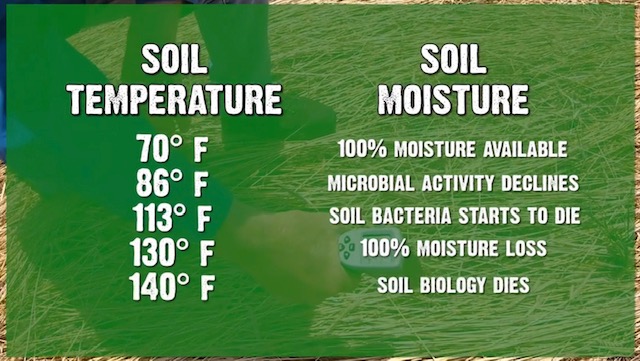As the temperature rises during the scorching summer months, it’s essential to understand how heat affects soil health and plant growth. From microbial activity to the development of heat stress in lawns and gardens, temperature plays a crucial role in shaping our outdoor environments.

At an optimal temperature of around 70°F, soil teems with life, and moisture is readily available for plants and microbes alike. This sweet spot fosters robust microbial activity, essential for nutrient cycling and soil fertility. However, as temperatures climb, microbial activity begins to decline, with significant consequences for soil health.
When temperatures reach 86°F, soil bacteria start to perish, disrupting the delicate balance of the soil ecosystem. As the mercury climbs higher, reaching 113°F, soil biology faces further devastation, with detrimental effects on plant growth and nutrient availability. At 130°F, soil moisture is lost entirely, leaving plants parched and struggling to survive. And at a scorching 140°F, soil biology ceases to exist, leaving behind a lifeless landscape.
But it’s not just soil that feels the heat – plants also bear the brunt of rising temperatures. As lawns and gardens bake under the summer sun, plants may wilt, turn brown, or even die from heat stress. Brown spots dotting a once-lush lawn are a telltale sign of water scarcity and heat-induced damage, exacerbated by factors such as fertilizer use, lack of organic matter, reduced water availability, evaporation, and legacy issues like pet damage or winter salts.

To visualize the impact of temperature on soil and plant health, consider the stark contrast between two images: one showing a lawn with dead, brown spots from lack of water, with temperatures soaring to 136°F, and the other showcasing vigorous crabgrass growth in slightly cooler conditions at 90°F. These images underscore the critical role of temperature in shaping our outdoor landscapes and the need to mitigate its adverse effects.
In the battle against heat stress, understanding the principles of exothermic and endothermic processes is crucial. While bare soil and heat islands contribute to exothermic heat production, photosynthesis acts as a cooling mechanism through endothermic energy absorption. By harnessing the power of plants to cool the environment, we can create more resilient and sustainable landscapes.
As we navigate the challenges of rising temperatures, it’s essential to adopt practices that support soil health and mitigate the effects of heat stress on plants. From maintaining optimal soil moisture levels to promoting microbial activity through regenerative practices, there are steps we can take to protect our outdoor spaces from the heat’s harmful effects.
Thank you for joining us on this exploration of soil temperature dynamics and plant resilience. If you found this discussion intriguing, we invite you to explore our archive of over 200 blogs for more captivating insights into regenerative lawn care and soil health. There’s a wealth of knowledge waiting for you to discover. Happy reading!